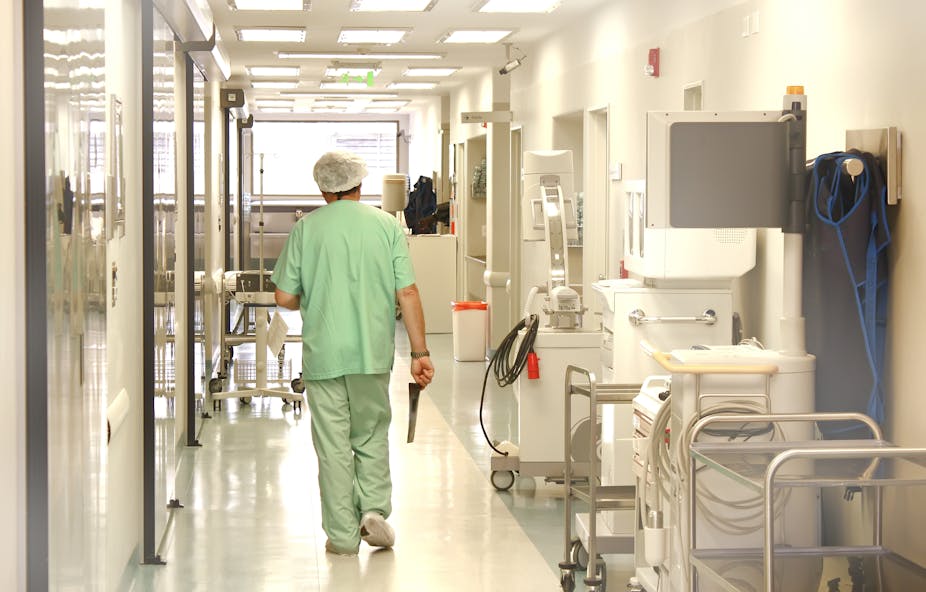New medical technologies and treatments over the past few decades have led to remarkable improvements in treating older patients. The annual death rate for an 80-year-old male in 2011 was just 5.6%, compared with 10% thirty years earlier.
But health-care costs are rising inexorably due to our ageing population. The elderly use hospitals at three times the rate of middle-aged Australians. Costs of hospitalisation rise steeply with age as sicker patients need to stay longer in hospital.
Hospital resources can only be stretched so far. As more and more patients arrive in emergency departments and need admission, the capacity to perform elective surgery is reduced, and waiting times increase.
So, how will our hospitals cope with the inevitable influx of large numbers of elderly patients and their increasingly complex needs?
Hospital reforms have focused on efficiency gains and “doing more with less”. But this alone won’t enable hospitals to respond to these new challenges. We need to redesign the workforce so hospitals are staffed by general physicians and nurses who take on more complex roles.
Medical generalists
As we age, our risk of developing chronic diseases – such as heart disease, cancer, diabetes, osteoporosis, depression and dementia – increases. And because we’re living longer, we’re more likely to have multiple chronic diseases; in fact, this is becoming the norm, rather than the exception.
Hospitals traditionally treated patients with one disease who were seen by doctors who specialised in a particular part of the body or type of treatment. But patients with multiple illnesses need a generalist to manage their care.
This is also the case in the United Kingdom, where the Royal College of Physicians recently recommended a radical overhaul of the purpose and role of hospitals. The college argues that in future, hospital will need more generalists and fewer specialists.
The same is true for Australia. While general physicians are assuming a more prominent role in acute inpatient care, there is a shortage of experienced generalists and training positions.
Luckily, with an anticipated oversupply of medical graduates in Australia over the next few years, there is an opportunity to alter the structure of medical training to promote flexibility and generalism for medical careers.
State governments, however, need to actively support training programs for general physicians and include rotations through specialties. This will create the cadre of outstanding clinicians who can reduce the need for over-investigation and promote timely, holistic hospital care.
Specialist nurses
The increasing pressure of chronic diseases on hospitals and increased demand for beds will require nurses and doctors to work very differently to the way they have in the past.
Nurses will need to be better utilised, in more specialist roles. With the right support and development pathways, for instance, nurses can safely perform medial procedures such as endoscopies and colonoscopies, which use a long tube with a video camera and light on one end to examine the inside of the body. Nurses can also oversee patients’ chronic disease management programs for illnesses such as diabetes and heart disease.
Grattan Institute health economist Stephen Duckett has previously proposed up-skilling hospital-based nurses to ease the pressure on hospitals. By employing nursing assistants to undertake more administrative tasks, nurses would be free to take on more complex roles. This could help create more rewarding jobs and a more sustainable health-care system.
Nursing researcher Stacey Leidel agrees. She argues that the way forward is to reinvigorate the role of the clinical nurse consultant, rather than up-skill specialist nurses (nurse practitioners, who focus on a specific area of clinical care). These clinical nurse consultants would be educated according to a generalist framework, based on national priorities.
However, the cultural barriers to nurses increasing their scope of practice span legislative, administrative, professional and societal domains. The argument for change will require attention to fear as much as logic and evidence.
What progress is being made?
Disruptive innovation will need to challenge professional silos built around specialisation, as well as stereotypes.
This fresh approach is starting to appear in a diverse range of settings, such as the Mayo Clinic, where the Center for Innovation’s mission is to transform the experience and delivery of health care through the application of design thinking.
In New Zealand, the Ko Awatea Centre at Counties Manukau DHB in Auckland is changing the stance and perspective taken by health-care workers as a first step to co-design of services.
Locally, Monash Health in Melbourne has reorganised its general medicine model of care across three acute hospital sites. Senior nurse nurses and allied health practitioners now work in specified roles to coordinate integrated care. And general physicians focus on providing timely appropriate care across the hospital.
The increase in patient admissions under general medicine over the last five years has been accompanied by a reduction in length of stay which would otherwise have required an additional 120 beds to be opened. In other words, the operating efficiency gain is equivalent to 120 beds.
Towards more integrated care
In order to create the radically different hospital to meet the needs of the rapidly ageing population over the next 20 years, we need to create new roles for health-care workers and challenge traditional siloed professional practice.
Health services must bring design thinking and systems thinking together to create truly innovative health care services that make patient and front-line team experience the priority. In doing so, we must see the patient journey as an integrated whole and focus on providing effective care for our patients.
This, of course, will require effective care teams and clinical leadership. To achieve this vision, enlightened hospital decision-making boards will need to challenge service providers to take this radical design approach. And governments will need to support a more strategic approach to workforce training for doctors, nurses and other health providers.

